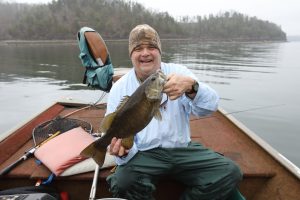Although we’ve seen many warm fronts this winter with temperatures in the 60s just this past weekend, the water in our highland reservoirs is still cold.
Water temperatures are in the high 40s in Lake Cumberland, Dale Hollow and Laurel River Lake. Once water temperatures drop below 50 degrees for extended periods, threadfin shad begin to suffer from the cold water.
“Threadfin shad get thermally stressed by winter water temperatures, especially in late winter,” said Jeff Ross, assistant director of the Fisheries Division for the Kentucky Department of Fish and Wildlife Resources. “They begin to twitch and spasm as they try to fight off death.”
Smallmouth bass, as well as spotted and largemouth bass, instinctually know to eat these weakened baitfish. The float-and-fly technique imitates stressed shad in cold water as good as anything.
“Many bass lures, such as jerkbait, use twitching movement to draw strikes,” Ross said. “The little fly twitching in place is irresistible to a smallmouth in the winter.”
Born in the deep, clear lakes of east Tennessee and inspired by crappie anglers complaining of big smallmouth bass breaking off tiny hair jigs fished deep in the winter months, the float-and-fly technique employs long, light to medium-light power spinning rods and 4-pound line to present small 1/16-ounce to 1/8-ounce jigs under a bobber.
The tiny jig is the “fly” in the float-and-fly technique. For generations, smallmouth anglers in Kentucky and Tennessee call hair jigs “flies.”
The long spinning rod, from 8 to 11 feet in length, is necessary as you suspend the diminutive jig 8 to 14 feet deep. Casting such a presentation on a rod shorter than 8 feet is nearly impossible. Fly anglers use 8-weight rods to suspend 1/32- to 1/48-ounce jigs under large strike indicators, employing light fluorocarbon line as the tippet. The lighter 1/48-ounce jig is much easier for a fly angler to cast with a leader and tippet running at least 8 feet long.
The “flies” are made of either craft hair or duck feathers or a combination of both. The float-and-fly technique has grown so popular that national outfitters carry rods designed for it. Tackle shops in the Lake Cumberland and Dale Hollow Lake region sell them as well. Float-and-fly rods also make excellent crappie and panfish rods.
 All you do is load the spinning reel with 4-pound co-polymer or fluorocarbon line and clip on a 7/8-inch pear-shaped plastic bobber 8 feet above the fly. Adjust the depth of the fly until you get a “pull down” on the bobber from a fish. There are specially weighted foam bobbers designed for the float-and-fly technique that grant better casting distance. The internal weight in these bobbers makes them roll over on their side if a big smallmouth hits the fly and moves shallower.
All you do is load the spinning reel with 4-pound co-polymer or fluorocarbon line and clip on a 7/8-inch pear-shaped plastic bobber 8 feet above the fly. Adjust the depth of the fly until you get a “pull down” on the bobber from a fish. There are specially weighted foam bobbers designed for the float-and-fly technique that grant better casting distance. The internal weight in these bobbers makes them roll over on their side if a big smallmouth hits the fly and moves shallower.
Lake Cumberland presents an ideal opportunity to catch smallmouth bass, as well as fat, healthy spotted bass and even hand-sized bluegill on the float-and-fly right now. During the drawdown of Lake Cumberland to repair Wolf Creek Dam several years ago, trees grew on the exposed shoreline. Now with normal water levels, these trees are at the perfect depth to offer shelter for big smallmouth and spotted bass as they await a school of baitfish to ambush.
The quivering fly hovering just above the sunken trees pulls these fish out of their lairs to strike. Female smallmouth bass need to feed in late winter to power the development of the eggs in their abdomens they will drop into nests later this spring.
The best flies on Lake Cumberland are craft hair jigs in combinations of blue, chartreuse, grey or white. White, sky blue and pink craft hair jigs also work well on this lake.
Duck feather jigs with wisps of red or pink craft hair seem to draw more strikes on Dale Hollow. These colors work well at Laurel River Lake, too. Both Dale Hollow and Laurel hold trout and some anglers believe their presence makes these fly colors work better in these lakes.
Fish the float-and-fly near the main lake in winter on these reservoirs. The best fishing occurs when your back faces lots of big, deep water.
Remember to allow your fly to strike the water’s surface on the back cast. This provides resistance on the forward cast that loads the long spinning rod, leading to much improved casting distance.
Applying a petroleum jelly-based shad scent, called “fish dope,” improves the delectability of the fly to smallmouths. Tackle shops and retailers in the Lake Cumberland or Dale Hollow region sell fish dope, but any petroleum jelly-based shad scent will work. Those with glitter in them are best.
On bright days, trimming a fly to match the bend of the hook and heavily applying dope to where the fly resembles a small stick often makes the difference between being skunked or catching fish.
A month of good float-and-fly fishing awaits anglers until warming waters puts big smallmouth or spotted bass on the prowl and willing to chase lures. This technique also fools huge largemouth bass on farm ponds and small lakes in late winter.
Remember to buy your fishing license soon. Feb. 28 is the last day of the current license year in Kentucky.
 Weather
Weather Traffic
Traffic @LouisvilleDispatch
@LouisvilleDispatch @LouisvilleDisp
@LouisvilleDisp Subscribe
Subscribe


Leave a Reply